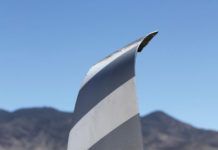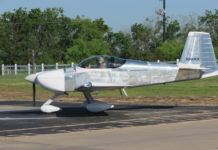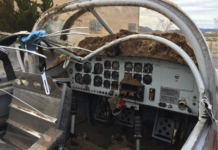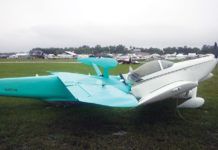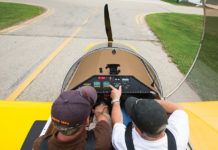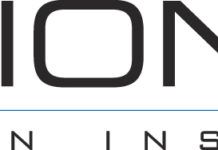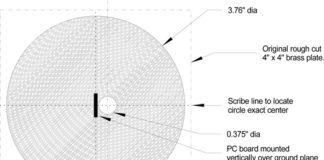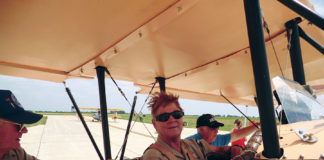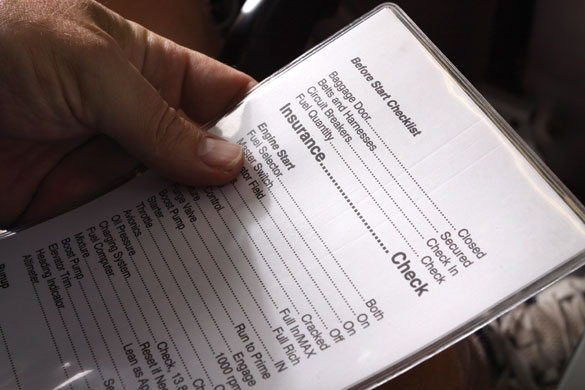
As the economy has continued to whipsaw, we couldn’t blame general aviation pilots for admitting to a good dose of shock and uncertainty. Every facet of the financial sector has been slammed, and its natural to wonder whether the health of the aviation insurance industry has been pulled along for the beating. The good news is, not really. We took a look at the current state of aviation insurance for homebuilts and Light Sport Aircraft and, overall, its in pretty good shape.
To get a feel for the current insurance market, we spoke with Bob Mackey, a representative of the EAA Aircraft Insurance Plan, administered by Falcon Insurance Agency of Kerrville, Texas. Mackey noted that overall the insurance market continues to be supportive of Experimental aircraft and LSAs. The underwriters have not reacted sharply to the recent economic traumas, and have maintained their conservative stances and requirements in writing insurance policies. Economic sluggishness may, however, affect the number of hours a pilot flies during the year. If a pilot has committed to, say, five hours of wings proficiency training for a high-performance Experimental, and either fails to take the course or doesn’t fly as much, that will almost certainly change his annual premium.
What to Fly?
Generally, if an Experimental aircraft is among the more popular models-that is, it isn’t a one-off orphan-purchasing insurance is not a real problem. As the number of flying examples of an aircraft increases, the better the rates may be. Whether you’ve chosen a kit aircraft or an LSA (factory-built or kit), the stability of the company, the availability of parts and factory support are key. When underwriters are on board with factory-provided training programs, they may waive a certain number of training hours. If a manufacturer is not quite there yet, the underwriter may stipulate a specific number of checkout or training hours before signing off on a policy.
Mackey agreed that challenges arise when a builder has completed a one-of-a-kind airplane, has made some wild modifications to an existing design, or has just built an aircraft that is not at the top of the popularity charts. It takes a lot of work, but we can still do some pretty innovative things in getting underwriters to provide insurance where years ago they wouldn’t, he explained.
Jim Lauerman, president of Avemco Insurance of Frederick, Maryland, looks for three traits when underwriting homebuilts: Are there enough of them out there to provide a legitimate support structure? Can the owners get parts to repair them? Are the designs standard enough so that they can be maintained and repaired easily? Still, there is no magic number of examples that makes an aircraft insurable. Lauerman says that his company uses common sense as a guide, and likes designs that have been out there for a while with reliable factory support. The existence of an owners group indicates that there are sufficient parts and expertise to support and repair the planes.
It helps to be known. A couple of the underwriters are aggressive on the more popular designs, Mackey says, but thats not across the industry. Sometimes underwriters will find an airplane that they’re really keen on, and theyll cut the rates on that one because they’re really impressed by it. But I don’t see that uniformly, like they’re lining up behind one specific aircraft and trying to fight over those.
What about kit aircraft companies that have been around for a while, but have gone out of business or are discontinuing factory support? Lauerman said that argument could be made with the Cessna 152 or Grumman American aircraft. While they are not being produced anymore, there are still thousands of them in the wild, and parts are widely available. As long as there’s support for the aircraft, whether the company’s in business or not is less of a problem, he explained. With relatively good parts availability, they tend to be treated kindly by underwriters.
He added that the beauty and the bane of the Experimental aircraft world is that some companies do exit and then re-enter the entrepreneurial stage. Underwriters like predictability, which is one of the reasons Experimentals may have had slightly more difficulty getting insurance than certified aircraft.
LSA Transition Training
Mackey emphasized that its important that pilots maintain their proficiency, whether they’re trading up to a higher-performance aircraft such as a Glasair, Lancair or RV, or trading down to a more sedate homebuilt such as a Zenith 601, 650 or a low-and-slow Kitfox. Because Falcon seeks quotes from all of the insurance companies (with the exception of Avemco Insurance, a direct insurer), Mackey has heard from a number of underwriters about their requirements and preferences. From time to time, they will encounter veteran pilots who don’t feel they need a 5- or 7-hour dual transition training program when moving to a Light Sport Aircraft. The underwriters insist on it, however, because such aircraft frequently have characteristics that are much different from previous airplanes the pilot may have flown.
Transition challenges can run the gamut for everyone from recently retired airline pilots who have flown a little bit of GA, to highly experienced corporate pilots who are getting back to personal flying after letting their medical lapse. Mackey told us, Every once in a while, you’ll run into somebody who feels thats a little bit onerous [the transition training]-they don’t think thats necessary. When the underwriters put their money up for a $150,000 airplane, and a million dollars worth of liability, they’re going to be cautious about that, because their experience has indicated that transition pilots can be a problem.
A transitioning pilot will pay a higher premium because the insurance companies experience more losses during this phase, though premiums will generally drop after the first year. If a pilot flies only 25 to 30 hours that first year, however, the higher premium will probably persist. If that same pilot flies 100 hours or more during the first year, adds recurrency training and picks up additional ratings or endorsements, he could see a substantial reduction in the premium-perhaps a savings of as much as 25% to 35% annually.
Because many LSAs are much more lightly wing loaded than some common certified single-engine aircraft, with more lightness in the controls, crosswinds and turbulence will affect them more abruptly. Lauerman noted that this has proved to be a challenge to seasoned pilots, and insurers found that a lot of their claims occurred very early in the new owners experience. In an aircraft with a stall speed of 35 knots, a 15-knot crosswind is a much bigger deal than it would be in a medium-size twin. With lower wing loading and a slower stall speed, its important to become comfortable with the lower end of the performance envelope. He added that as these transitioning pilots gain more experience in the slower and smaller aircraft, the losses will decrease.
Rather than requiring a standard checkout, Avemco requires a 5-hour transitional program for the LSA pilot, as well as the completion of a flight review in that aircraft by a CFI prior to the owner operating the aircraft as pilot-in-command. The flight review adds accountability to the process, as the pilot must demonstrate competence in that specific aircraft. Since we’ve done that, our underwriting results have improved quite dramatically, Lauerman observed. Interestingly, a few customers who initially balked at the requirement got ahold of us later on and said, Im glad you made me do it. Its not that the airplanes are unsafe, but they are different from higher-performance aircraft.
Transition training can range from a personalized program with a CFI with sufficient hours in type, to a factory designed and approved syllabus. Scott Dyer, an ATP based in Westchester County, New York, points out that transition training takes a lot of patience and the willingness to adjust your flying habits, especially if you’ve spent a long time going fast. He recalls clearly a long-ago flight in his Piper Archer with a retired airline pilot who wasn’t accustomed to the sight picture on landing. His eyes got bigger and bigger-he wanted to flare 50 feet up.

Venerable designs such as the Vans RV-8 (left) are more insurable because of fleet size. (Just watch out for the high-performance premium.) New Special Light Sport Aircraft like the Gobosh (right) are getting easier to insure as pilots learn about their handling qualities.
HP Transition Training
Upgrading to a higher-performance Experimental such as a Lancair or Glasair has its own challenges. A higher degree of skill and proficiency is required to master designs with high wing loading (more than 15 to 20 pounds per square foot), and they are tougher to insure. Companies such as Lancair, Vans Aircraft and Glasair provide factory training, which is a benefit in getting full insurability.
With more than 6100 completed RVs to its credit, Vans Aircraft features a manufacturer-approved transition training program for builders or for pilots who purchase a used RV. The transitioning pilot must be current in other GA aircraft, with tailwheel or high-performance endorsements, if needed. The program is not intended for general flight training or proficiency training; it is specifically designed to teach the safe operation of an RV. Vans recommends several CFIs for this training (they’re listed on the Vans web site), but other CFIs around the country also provide RV transition training and can be found through EAA, NAFI (National Association of Flight Instructors) or your insurance company.
Pete Zaccagnino, the owner of High Performance Aircraft Training, Inc., of Clearwater, Florida, provides contracted flight and recurrency training for Lancair customers. The courses are given in either the customers aircraft or in the factory demo planes, and cover the Lancair 320/360/ES, IV/IV-P/ES-P and the Legacy. The pilot must be current and have a high-performance/complex aircraft signoff prior to taking the course.
CFI Training Requirements
Lauerman noted that Avemco does not employ any more stringent CFI qualification requirements than the FAA does. Obviously, we hope that people would get a flight instructor with very specific make and model experience, but we generally don’t dictate what flight instructor they have to get. He noted that two of their earliest LSA claims were with the flight instructor on board doing the checkout with the owner of the aircraft. A little crosswind and a little gustiness, and neither one of them could handle it, he said.
Falcon likes to see an instructor who has not only passed through the low-time danger zone, but has sufficient and relevant experience to be able to instruct in these aircraft. A CFI with 300 hours of total time, with 50 hours of dual given in a 172, may not cut it. Mackey said it would not be an issue for, say, an instructor with about 1300 hours of total time, with closer to 400 hours of dual given, including some time in Citabrias or J-3s, which have the light stick control and light wing loading that characterize many LSAs. The underwriters will often offer terms on the policy if the CFI obtains a checkout in the aircraft, followed by a minimum of 10 hours in the plane before giving training to the new owner.
New owners may also be required to have 15 hours of dual before they’re signed off for solo. Depending on the pilot and the aircraft, Falcon may require them to have a minimum of 30 takeoffs and landings to a full stop before solo.
Primary Training
It wasn’t long ago that the thought of a student pilot committing primary training in an Experimental/Amateur-Built was strictly verboten. Mackey has found that if the pilot uses an appropriate airplane for a training platform, even if its Experimental, Falcon has been able to write an insurance policy. However, the solution is not always exactly what the person is looking for. A new pilot-to-be may become smitten with the svelte looks or robust performance of any of the fast glass models, but while a Glasair III or Lancair IV are solid, proven designs, the high-performance, high-wing-loading characteristics do not lend themselves well to primary training. Insurance companies are skittish enough about insuring fast-glass aircraft-instrument ratings are generally required, and they will insure such a pilot for recurrent training. Even so, insurance under those circumstances is expensive, and many pilot/owners will buy liability insurance only. Mackey said that he had never seen an underwriter who was willing to insure a primary student in these aircraft.
What does Falcon need to see in a good training platform? Moderate wing loading, sturdy landing gear, a stall speed at or below 65 mph or so, usually with tricycle gear and standard construction techniques. Designs such as the Zenith 601/650, Sonex, Vans RV-9, -10 and -12, and some RANS models (S-6S, S-6ES, S-7S and S-19) have generally predictable handling characteristics, and they’re insurable for primary training.
Flying Lightly
Mackey noted that while the underwriters have slightly softened the prices of premiums for many Light Sport Aircraft, that is not the case with LSAs that have migrated from the two-place ultralight community. The Hornet, the Quad City Challenger and the X-Air are several examples of these aircraft, and while they have solid histories, underwriters tend to view them differently than the Experimentals whose roots are planted in the GA branch of the family tree. Some of the underwriters are a bit standoffish and more cautious, because they [the former ultralights] don’t have a full cockpit around the pilot, Mackey said. They’re a little more reluctant to be more aggressive on those, and some wont insure some of those airplanes.
When underwriters walk the flight line at AirVenture/Oshkosh, their first impression of an ultralight is that there’s not a whole lot to the aircraft, especially if they learned to fly in a Cherokee or Cessna 152. Mackey said that the EAAs insurance staff has offered familiarization flights to underwriters for years in everything from powered parachutes and weight-shift controlled trikes, to various Experimentals and Light Sport Aircraft. We try to get them up flying, and they start to understand, he said. These are underwriters who deal with everything from corporate jets to flight schools and individual aircraft. They may have never been up in something like that-experiencing a new type of flying in an open-cockpit airplane where you have the whole world in front of you, and they’re enthralled by it. They all come down and say, That was really cool.
Of course, it takes more than an exhilarating flight to capture the heart of an underwriter-it takes hard data. When they talk with the designer or importer/distributor about a certain aircraft, examine the design and see that perhaps the airplane is built in a factory adjacent to a corporate jet factory, they’re able to put the additional data into the decision-making mix.
Other Trends
Falcon continues to write builders insurance, with premiums staked at approximately 1% of the value of the kit. Mackey notes that its not a high-premium volume area, and not a high loss volume area; losses and claims during this phase of kit ownership are uncommon. Generally, a builder will buy project insurance when the investment in the project has reached a certain point, and usually before the home-based project is trailered to the airport.
Insurance companies do recommend project insurance during the building process, particularly when the value of the work in progress is not covered by homeowners insurance. All documentation and receipts for the kit should be stored in a fireproof safe in another location. Most homeowners insurance policies include liability insurance that will provide coverage if someone is injured, or if property is damaged due to the builders negligence. Mackey noted that none of the insurance companies that write project insurance policies have walked away from this segment of the business, and policies continue to be readily available.
With respect to rates, Mackey added that the size of the entire aircraft pie is about the same as it was in 2004, with more aviation insurance companies in the market fighting over each piece. Some of the underwriters have gotten aggressive across the board, in standard category airplanes as well as Experimental/Amateur-Built and Light Sport. Theyll get really aggressive about very popular designs that they feel comfortable with, and that have reasonable repair costs. However, an airplane that doesn’t have support anymore, or a unique and labor-intensive airplane such as a Falco, wont receive the same attention and attractive pricing from an insurance underwriter.
Underwriters will offer more favorable rates for a private pilot with 1000 hours overall, and 300 hours in a particular make and model. A pilot with only 200 hours total time, and 25 hours in the make and model, will pay a higher premium. Still, in the current economy, with things slowing down, insurance companies don’t want to miss writing a policy for a plane/pilot combination they’re comfortable with.
Whither the Economy?
Speaking of the economy, Lauerman confirmed that there definitely has been some decrease in activity, generally matching the downturn in the other aspects of the aviation industry. He added that many single-engine GA planes, as well as the simpler Experimentals and LSAs, have been less affected by the economic downturn than the high-end airplanes. Its not devastating, but we definitely think the industry has seen a contraction in the last 12 to 24 months-I don’t think there’s much question about that.
Regarding works in progress, Lauerman believes that there may be fewer kit starts than in the past, but builders who have already started a project are likely to finish it. If he has a financial investment in it, why not get some value out of it? he explained. Were not contracting our business in either homebuilt or Light Sport. Were hoping for a bright future for this industry, and think there’s an awful lot of good going on in it.
What about AIG? The financial services arm of AIG experienced massive financial troubles and received the infamous government bailouts. According to Mackey, The insurance units of AIG, covering aviation auto and life, are tremendously financially sound, and always have been. When the big AIG found itself in trouble because of the areas of business it was conducting, everybody thought that anything that had AIG on the label was also in financial trouble. Thats not the case. Insurance is highly regulated, so if there’s any question about a company’s financial situation, its rating changes, and we watch that very closely.
The aviation insurance business has always been cyclic. When the capacity dwindles, and some of the companies back away from underwriting certain segments of aviation, the pricing starts to trend upward. When there’s excess capacity, the pricing trends downward. It generally starts with the very big accounts such as airlines, product and aerospace, and then follows into commercial general aviation, then noncommercial general aviation, and then the individual account holders.
Mackey doesn’t see the capacity changing quickly, if at all, and doesn’t believe the pricing structures will change significantly either way in the next few years. He has noticed some slowing in the market, and airplane values have softened a bit. This has resulted in some people who have the cash or excellent credit seizing the opportunity to buy an airplane that theyve wanted to buy for years, but felt they couldn’t afford. He believes the associated ownership and operating costs will be stable, and has also observed more caution about buying aircraft, with potential owners asking themselves whether they need to spend the money right away.
He added, There are fewer airplanes changing hands, fewer people out buying insurance. But people who do have airplanes are continuing to insure them. And if you’re financing it, you have to continue to insure it. A bad economy doesn’t mean bad decisions. He also cautioned against the temptation to reduce your airplanes value and underinsure it, and recommends setting aside about 10% of your aircraft budget for proficiency training.
The temptation to cut back on flying during tough economic times decreases a pilots proficiency and overall safety, as well as the planes mechanical health. Lessened pilot proficiency is also a significant factor in increased premiums. That annual insurance questionnaire takes your hours flown into account when calculating the premium. Some pilots, daunted by fuel prices or ongoing operating costs, may opt to increase their simulator time, just to keep their head in the game.
What are people not doing? According to Mackey, People aren’t calling me and saying they don’t want to insure their airplane anymore, they’re locking it up in the hangar.





